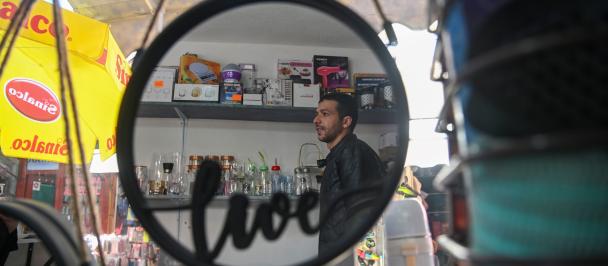Artisans demonstrate the stellar potential of clay livelihoods on the last of Jamaica’s vanishing clay fields
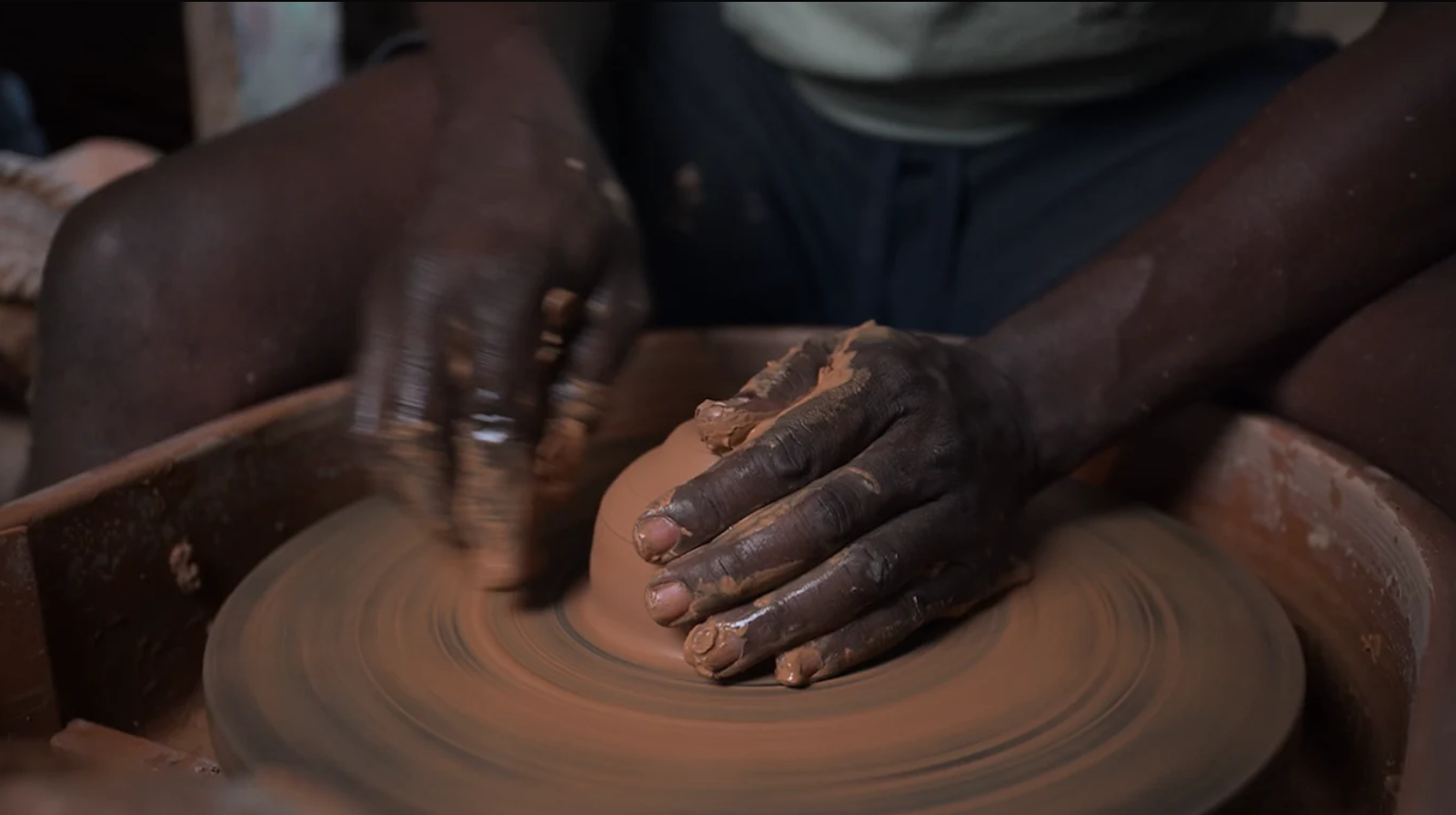
Photo: UNDP/Ricardo Makyn
Close to home
When Fabian Rainford gets ready to mould and fire clay pots for sale, he takes a short walk to one of the last remaining clay fields accessible to artisans anywhere in Jamaica.
With pickaxe he cuts the impacted raw clay into chunks, packs them in bags and buckets and transports the raw material on foot to his nearby container studio. Home is round the corner, along a narrow road lined back-to-back with houses, some clustered in tenement yards. Some of these yards host kilns and potters’ wheels. Trees are everywhere.

Fabian Rainford on a short walk from his container studio with pickaxe, bucket and crocus bag to collect clay from the nearby Rose Town clay field.
This is Rose Town, a lower income residential community renowned for its clay field, and more so for the generations of potters who make a living from it. It's minutes from Trench Town, immortalized by reggae legends Bob Marley and Peter Tosh but also famous for its own trendsetting potters and clay fields.
Rose Town is alive with the entrepreneurial spirit of its artisan community, nurtured by the Rose Town Foundation for the Built Environment from its base at a blue, art deco styled building.

The clay field of Rose Town. Like many inner-city communities in Jamaica, it's surprisingly leafy, cooled by trees and framed by the distant Blue Mountains.
Seventy-four kilometres south west of Kingston, on the Clarendon plains, Robert Campbell of Khadabra also has instant access to clay fields in the low-income rural community of Race Course. His studio, a converted home flanked by neighbouring homes, produces high quality clay pieces for sale in both international airports and retail shops patronized by locals and tourists.

At first, I had the business name Hands In Clay, but since we started working with a lot of different materials, we decided that we need a different name. I chose the word Khadabra, from the word Abra Khadrabra, which means I create - Robert Campbell
70% of Jamaica's clay deposits are lost - overbuilt by construction
Jamaica is rich in clay, a Development Mineral – 160 million metric tonnes to be exact – which is the depth and weight equivalent of 483 Empire State Buildings.
But 70 percent is now overbuilt or lost to construction, due to poor spatial planning.
Despite these losses, clay is still abundant in communities like Rose Town, Trench Town and Race Course, utilized by a small but increasingly productive army of clay artisans – for now.
But that could change if existing fields presently accessible to artisans are lost to buildings, car parks, housing and other types of development.
Every now and then Rose Town hears unverified rumours that their clay field is earmarked for development, but artisans like Rainford cling to hope – that authorities will catch their vision for sustained development and self-employment for the skilled crafts persons from places like Rose Town, Trench Town Race Course, Savanna La Mar, Kingston, Highgate and Falmouth.
It is true that artisans could dig clay in other locations, but community fields help eliminate a chunk of production costs which sustains the viability of their home-based enterprises, while helping to reduce poverty.

Kneading clay into mask moulds at Khadabra in Race Course, Clarendon.
Spotting the potential of this niche sector, the ACP-EU Development Minerals Programme financed by the European Union (EU) and implemented by the United Nations Development Programme (UNDP) and the Mines and Geology Division of the Ministry of Agriculture, Fisheries and Mining, supported small scale artisans retool and upgrade equipment. The aim is to bolster productivity, jobs and income with small grants and training. During COVID, additional grants bolstered MSME resilience and kept production going, cauterizing heavy losses.
Artisan capacity building is one component of a 1.4 million USD (1.3 million Euros) investment by the EU through the UNDP-implemented project to bolster the profile and profitability of Jamaica’s Development Minerals industry over nine years (2016 to 2024).

Rose Town Foundation Executive Director, Letta Gayle, welcomed the support from the programme and its capacity building efforts which are providing self-employment opportunities and impacting artisan output.
Besides local markets, artisans could conceivably tap into a lucrative global Pottery Ceramics Market valued at USD 262.8 billion in 2024. This is forecast to reach USD 421.8 billion by 2033.
Rose Town Foundation for the Built Environment (RTFBE) has been a steady partner through the years of cultivating the potential of talented artisans. Executive Director Letta Gayle welcomed the support from the Programme and its capacity building efforts which are providing self-employment opportunities and impacting artisan output.

Fabian and Robert are among 19 artisans awarded grants to bolster the artisanal side of the Development Minerals industry since 2017, impacting more than 700 persons - 239 directly and 479 indirectly - in communities averaging 6000 persons. Additionally, significant investments in capacity building since 2016 have helped build productivity, financial viability and environmental stewardship.

Jamaica’s entertainment and creative industries lost an estimated 173.3 Million USD (26 Billion JMD) during COVID, impacting 76,000 jobs. 95.5% of respondents in the creative sector experienced a loss of income due to the pandemic, a survey conducted by the Ministry of Culture, Gender, Entertainment and Sport reveals. Average estimated financial loss for micro-entrepreneurs in the sector was assessed at 10 666 USD ( J$1.6 million) per month. (UNDP/Ricardo)
Fabian - Passing on pottery skills while improving production

Fabian Rainfor, Potter from Rose Town, Jamaica
Rose Town’s Fabian, artisan producer of 20 years and community instructor to up and coming clay artisans, says his grant helped him create a productive workspace crafted from a container donated by the RTFBE. He added windows, doors, panes, bought tools and moved the retrofitted studio near the clay field.
Sponsored training in Tanzania sharpened his skills. “I learned how to make moulds and glazes and how to be more balanced in my approach to my craft", he says.
He’s most proud of passing on skills to youth from his community, partnering with the Rose Town Foundation and other potters like Theophilus Reid, a senior artisan.

Fabian at work in his container studio, retrofitted and equipped under a grant from the ACP-EU Development Minerals Programme implemented by UNDP in partnership with the Mines and Geology Division of the Ministry of Transport and Mining. The container was supplied by the Rose Town Foundation.

Rose Town Foundation’s Kimberley Black said Fabian’s work under the ‘18 to 80 programme’ with women was well received. “We came here on Wednesdays, and he would teach on how to make different types of things out of the clay - seahorse pots, cups, anything, you can name it”.
10 generations of potters
Reid works from his backyard, same place where he was born, inspired by the exploits of 10 generations of Potters who have brought renown to Rose Town. These days, the latest generation is continuing the legacy, selling to Barbican and Norbrook, upscale neighbourhoods in upper St Andrew and “pushing carts to sell and feed their families”, Theophilus explains.
With production improved, they can fill the big orders which occasionally come from owners of flower shops and plant nurseries. Up to 100 orders of clay pots are received in good times. “While times can be rough, positive things are still happening, and we can find our food and keep out of trouble. People are gravitating towards us and say they like our work. This motivates us,” he declares.

With production improved, they can fill the big orders which occasionally come from owners of flower shops and plant nurseries. Up to 100 orders of clay pots are ordered in good times. - Theophilus Reid, potter
Khadabra - creating and pivoting to keep business alive
In rural Race Course, Robert Campbell’s Khadabra, formerly branded Hands in Clay, received his first grant in 2017 under Phase I, and a second grant in 2022 under the Development Minerals Programme Phase II to support small business COVID response recovery. He purchased woodwork equipment to pivot a portion of his product line to a unique mixed clay/woodwork medium.
“This helped our business because at this critical time our business did not just slow down, it practically stopped.”

All our paintings, sculptures and ceramics, are a reflection of Caribbean lifestyle, and always has a reflection on our historical culture. - Robert Campbell, Khadabra (Hands in Clay).
“I (also) made kitchen fixtures and closets during the COVID time, with the equipment that we bought to keep my staff employed. Even after the COVID period, I find that it (continued to have) a good impact on the market" Robert reveals.
“And this is itself has been a plus. Even after COVID, we have had a lot of new products going out on the market, we are better positioned.
“The programme has truly, truly been beneficial, and we have more persons employed even after the pandemic, and this was all because of the funding. We were really able to do a lot more.
With water being an important ingredient in clay pottery, a water tank and pump was another essential purchase to address low water supply in the community. “There are times for days we would have no water, and it would slow down our operation, so we needed to store water.
Sponsored training in Tanzania was also a gamechanger, helping him to figure out how to use the kind of clay found in his parish.
“The clay in Clarendon, is useless by itself. But at training we learned about adding different materials (clay body) so that the clay could work. And this itself has been a tremendous impact on my business”, he explains.

With a COVID Response and Recovery Grant, Robert Campbell purchased woodwork equipment to pivot a portion of his product line to a unique mixed clay/woodwork medium.
"I created this business to help young people"
Khadabra has been a lifeline for many unattached youths over the years, especially in the period following the closure of the nearby sugar factory in 2019, just ahead of the pandemic crisis. Robert has been their dedicated mentor.
“I created this business to help young people not just to have a job, but to have a measure of discipline in terms of time management and the quality of their outlook on life. They are taught discipline, to be on time and to be efficient with work. We even discuss social life and I encourage staff to open bank accounts to start saving and to look at creating jobs.
When Robert arrived in Race Course, he started with one employee. Now he has six on his payroll, five of whom are from the community.

“I created this business to help young people not just to have a job, but to have a measure of discipline in terms of time management and the quality of their outlook on life. - Robert Campbell, Khadabra (Hands in Clay) top and bottom left photos and right top photo posing with his team at his studio in Race Course, Clarendon.
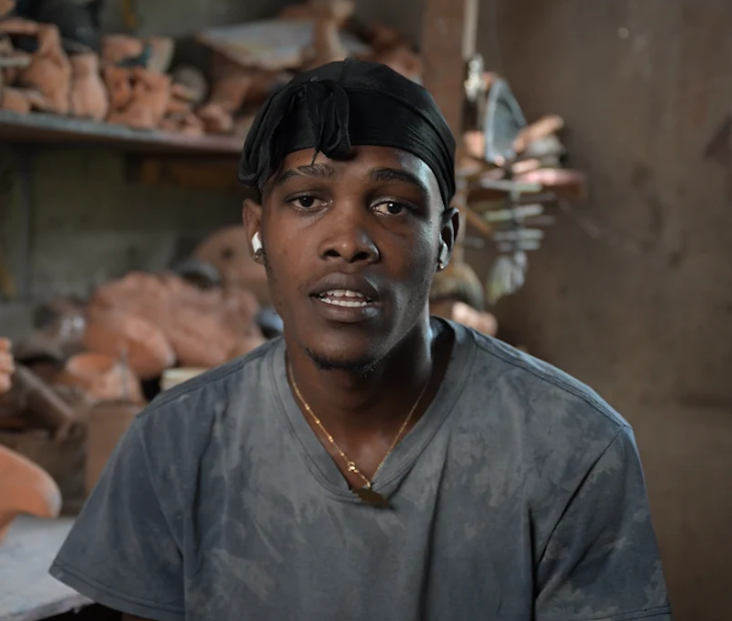
Anthony, potter, Hands In Clay/Khadabra Even after the pandemic, normally I was really a late bird. Honestly, if I got an award for being late, I probably would be late to collect that award. It has taught me to be a very punctual person.

Horatio, potter, Hands in Clay/ Khadabra I’ve been employed for maximum 10 years now, and it has taught me a lot. Yeah, like self dedication and confidence and determination".
Robert, Lenford and Theophilus, all artisans working the last remnants of accessible clay fields in two different locations have a few things in common: They are upskilling unemployed youth, creating jobs, generating income and feeding families from an underutilized development mineral (clay) ripe with potential.
Their work can only continue if have access to the raw materials, preferably close to home to help sustain current operational and production costs.


From left, Fabian, Theophilus and Robert -- two locations, both in need of easily accessible clay fields to sustain their operations.
Clay Fields should be kept clear
“The land should be kept clear because it is a natural source of raw materials for artisans, not just for those from Rose Town”, says Letta Gayle of Rose Town Foundation. “Artisans from across the country can benefit from this natural resource, but if we cover it with cement or any other thing, we lose out, and we should try our best to keep as much of our natural resources as possible”.
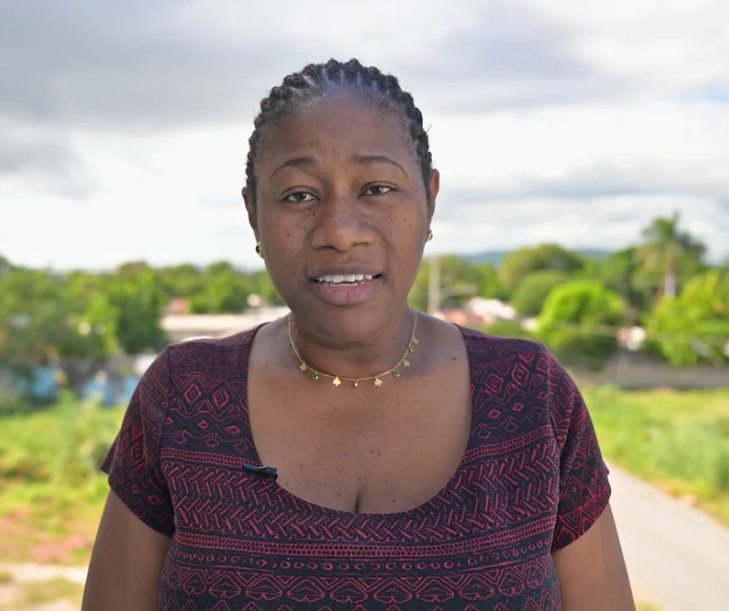
Letta Gayle of Rose Town Foundation: "“Artisans from across the country can benefit from this natural resource (clay), but if we cover it with cement or any other thing, we lose out, and we should try our best to keep as much of our natural resources as possible”.
Development Minerals Programme - a comprehensive approach
The Development Minerals Programme, a 1.4 million USD investment over nine years, is geared to bolster production and trade in underutilized development minerals and to help the sector showcase and fulfil its economic potential. Over both phases implemented in Jamaica, the programme has built the profile and improve the management of Development Minerals. This was achieved through in-depth capacity building, including: training; small grants; innovative technology products including the production of maps and databases; development of regulations on environment, health and safety; organization of community dialogues, technology fairs and networking events.

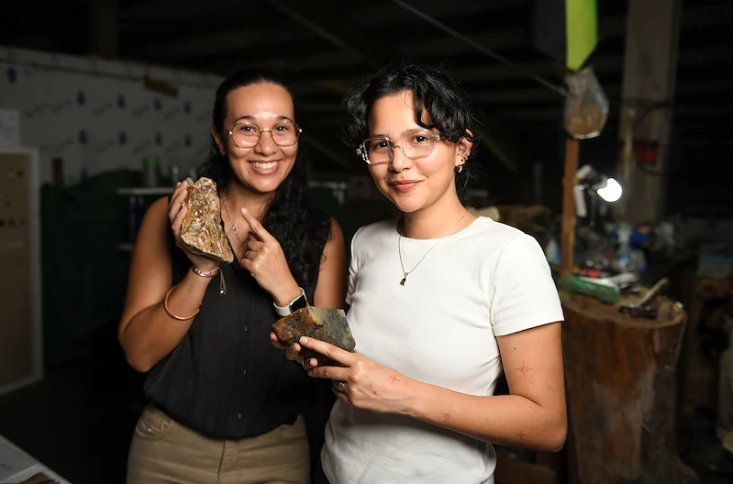


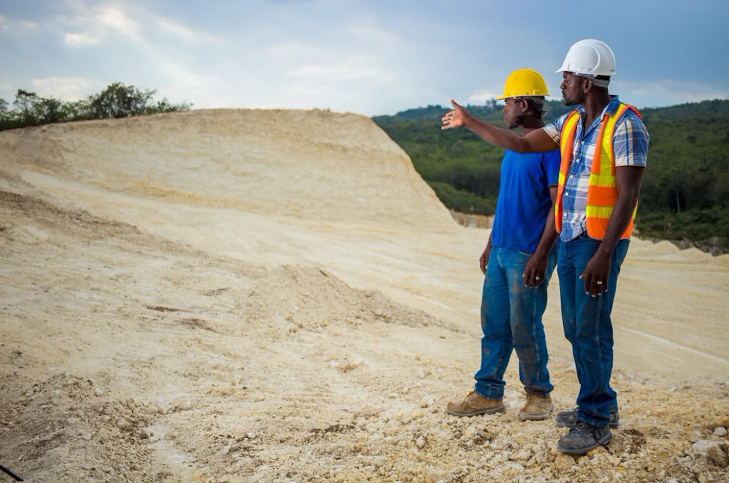
Photos depicting various aspects of the Development Minerals Programme in Jamaica through the years, including sustainable mining in St Elizabeth, Mines and Quarry management degree programme at University of Technology, the Mining Cadastre, and support for artisans.
Footnotes
Text written by UNDP Communications Analyst Gillian Scott. Thanks to Development Minerals National Coordinator in Jamaica Ruth Clarke; the Rose Town Foundation for the Built Environment; and Kahdabra (Hands in Clay). Photos by Ricardo Makyn for UNDP Multi Country Office in Jamaica.

 Locations
Locations

